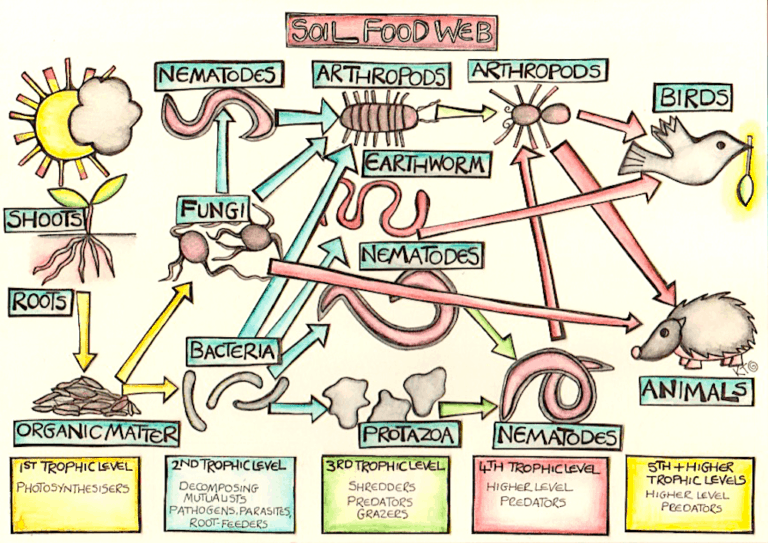Understanding your local ecosystem
Observations are always better applied when we have at least a rudimentary understanding of what you’re looking at! And when we’re designing our permaculture paradise, it is essential that we learn about our local ecosystem.
In our certification course, we have a large module devoted to learning about local ecosystems, and it still isn’t enough. However, since this course is supposed to be bite-sized, and also since we have students from all around the world, the best thing for us to do here is to show you how to learn about your own local ecosystem.

What is an ecosystem?
If this is a new concept to you, or even if you think you know what ecosystems are, take a minute to read the Wikipedia article on the topic–it’s actually a solid overview, and will set the stage for the rest of this article.
Also, here’s a lovely introduction from the Khan Academy, to how energy flows and matters are cycled through ecosystems.

Teaching Yourself About Permaculture
Rosemary Morrow’s book, Earth User’s Guide to Permaculture, is an essential for every permaculture bookshelf. But also, even if you don’t feel prepared to teach permaculture yet, her Earth User’s Guide to Teaching Permaculture is a powerful tool for learning, either alone or in a peer group. If you’ve got a book budget, get yourself a copy of each of these texts, asap. And for now, use this excerpt to teach yourself (and the stakeholders in your design) about local ecosystems.

Observation
If you do the hands-on assignment at the end of this What is Permaculture article, you’ll spend time observing a tree near your house, and looking for all of the relationships that tree has with its surroundings.
This sort of exercise is something you can use, again and again, on every layer of your design. Indeed, observation, while presented as the second step in our GOBRADIME design process, is truly the first step in every action you will ever take as a designer. Look before you leap, right? Yes, always.
- Don’t just observe with your eyes!
- Use all of your senses, including your intuition.
- Use your knowledge, of the place, of the patterns, of the people.
- Use your empathy, and imagine what everything you’re observing looks/feels/smells/tastes/sounds like, for creatures other than yourself.
- And, use your emotions, but not too much! Notice your preferences and aversions, your triggers and delights, but don’t allow them to influence your observations to the point of corrupting them. This is no small challenge, but…try.

This beautifully-written piece by Benjamin Weiss takes a naturalist’s approach to observation, within a permaculture context, and will give you lots of different things to “look” for.
Over the next several weeks, set aside a few minutes each day to cultivate your observation skills. If you have a site for your permaculture project, spend time observing every nook and cranny, making notes and taking notice of where systems connect, intersect, and collide. If you don’t have a site, spend time observing your neighborhood, exploring your larger community, and looking for options and opportunities you hadn’t noticed.

Finding a Local Mentor
The very best way to become adept at making designs that work ideally in your local ecosystem is to find a local mentor who can guide you toward the specific resources you need.
Do you have a local agricultural extension service? That’s a great place to start. Master Gardener program? Good too. Local permaculture people with long-term sites in their care? Elderly organic farmers, well-educated policy makers, and/or deeply committed stewards and scientists? Ideal. Find the people in your community who are learning, doing, and embodying this work, and connect with them. Help them with their projects. Be generous. And listen.
Want to learn more about this and other topics related to permaculture, sustainability, and whole-systems design? We offer a range of FREE (donations optional) online courses!
Use your observation skills to learn about your local ecosystem.
Go out for a walk, go the library, connect with local elders and mentors, and gather as much information as you can.
Questions to start with:
- What animals, birds, plants, and insects do you have locally?
- Where does the water come from, and where does it go?
- What plants are easy to grow in your local ecosystem, and which would be more difficult?
- Who are the primary, secondary, and tertiary consumers?
- What are the biggest threats to your local ecosystem, and can you see ways to help mediate them?
- Where are you, in your ecosystem, and how do your actions impact the ecosystem in which you live?

Relevant Links and Resources
10 examples of a natural ecosystem.
Check out this quick-n-simple overview, and see if you can determine what type of ecosystem in which you live. Read more….
Robyn Francis discusses a permaculture approach to climate change
Here’s a helpful and interesting video, from a high school biology teacher, about how ecosystems can be impacted by humans



